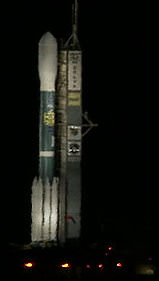[/caption]
[caption id="attachment_26634" align="alignright" width="159" caption="Kepler as it appeared moments prior to launch in Florida. Credit: NASA"]
[/caption]
NASA's Kepler mission lifted off without a hitch just before 11 p.m. local time Friday from Cape Canaveral Air Force Station in Florida.
The launch was a bit of a nail-biter, coming on the heels of last week's failure of the Orbiting Carbon Observatory, which plummeted into the ocean when its fairing malfunctioned. But everything for the Kepler launch -- from the weather to the countdown -- went flawlessly. At five minutes to launch, Kepler's rockets sent ribbons of smoke into Florida's 65-degree Fahrenheit (18-degree Celsius) nighttime air under perfectly clear skies. With 30 seconds left, confirmation commands were exchanged with practiced precision. The casing (called the fairing) fell off with grace, and three minutes into the flight, the craft was cruising away from Earth at nearly 7,000 miles (11,265 kilometers) per hour. Each launch event happened within three seconds of its predicted time.
Kepler's engines shut down at 11:45 p.m. U.S. eastern time, and the craft achieved separation just before midnight, about 62 minutes after launch. Now, for the next three and a half years, Kepler will trail Earth in orbit and stare at a single patch of sky in the Cygnus-Lyra region of the Milky Way.
Kepler fires the imagination, as it could finally address the age-old question of whether we Earthlings are alone. William Borucki, NASA's principal investigator for Kepler science, spoke about the mission at a recent NASA press conference and said if Kepler spies Earth-like planets in the habitable zones of other stars, "life may well be common throughout our universe. If on the other hand we don't find any, that will be another profound discovery. In fact it will mean there will be no Star Trek."
The $500 million Kepler mission will spend three and a half years surveying more than 100,000 sun-like stars in Cygnus-Lyra. Its telescope is specially designed to detect the periodic dimming of stars that planets cause as they pass by.
By staring at one large patch of sky for the duration of its lifetime, Kepler will be able to watch planets periodically transit their stars over multiple cycles, allowing astronomers to confirm the presence of planets and use the Hubble and Spitzer space telescopes, along with ground-based telescopes, to characterize their atmospheres and orbits. Earth-size planets in habitable zones would theoretically take about a year to complete one orbit, so Kepler will monitor those stars for at least three years to confirm the planets' presence.
Astronomers estimate that if even one percent of stars host Earth-like planets, there would be a million Earths in the Milky Way alone. If that's true, hundreds of Earths should exist in Kepler's target population of 100,000 stars.
 Universe Today
Universe Today

